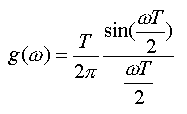
 |
Waveguide and |
|
For a signal containing only a narrow band of frequencies, the waveguide propagation constant b(w) may be expanded into a Taylor series about the center frequency w0. The propagation constants for waveguide WR22 and Tallguide TG31 are shown in Figure 1.
| ||||||||||||

| ||||||||||||
|
| ||||||||||||
|
| ||||||||||||
|
where L is the waveguide length. The velocity with which the signal propagates through the waveguide is equal to the waveguide length L divided by the time delay and therefore:
| ||||||||||||

| ||||||||||||

| ||||||||||||
|
where the phase velocity Vp = w0/b0 , C is the velocity of light and wc is the waveguide cutoff frequency.
If the band of frequencies is too large for only the first two terms of the Taylor series expansion of b(w) to give a good approximation of b(w) throughout the band, then additional terms must be included. These higher order terms always lead to signal distortion. In general, these higher order terms are difficult to evaluate unless the modulation envelope is a simple function with an inverse transform. For a unit pulse modulation envelope typical of radar with pulse width T, the pulse spectra is give by
| ||||||||||||

| ||||||||||||
|
M. P. Forrer, R. S. Elliott and others have shown that the terms up to and including the second derivative of the b(w) Taylor series expansion are needed.
To see the significance of dispersion distortion, we follow the unit pulse as it moves over a 20-ft. waveguide length. Following the computational methods of R. S. Elliott, C. M. Knop and G. I. Cohn, the output 38 GHz pulse envelope is plotted for various pulse widths. For WR22 and TG31, the Figure 4 series compares the output pulses for 5-ns (10-9 second), 2-ns and 1-ns input pulse widths. For convenience, the input unit pulse and output pulses are plotted on the same set of curves taking into account the 28.7-ns delay for WR22 and 23.5-ns for TG31. Note that for a 1-ns pulse width, the WR22 output unit pulse shape has completely distorted into a smooth curve.
| ||||||||||||
Our next task is to examine the influence of higher order waveguide modes on signal linearity. For standard waveguide frequency bands, waveguide dimensions are chosen so that only the single mode TE10 will propagate. Small manufacturing waveguide tolerance flaws and minor installation errors excite higher order modes, but these waveguide modes are evanescent and do not propagate. For Tallguide, however, the story is different. Even with precise electroform component manufacturing, no matter how insignificant the mode conversion energy is in the Tallguide interfacility run, the possibility still remains that some unwanted higher order waveguide modes may be excited. Tallguide transmission line dimensions often allow 15 or more higher order modes to propagate.
Without some form of mode suppression, the unwanted higher order modes are trapped between the two Tallguide transition ends. As shown in Figure 5, the trapping occurs, because at some point, the Tallguide transitions cutoff (narrows at point 1 and 5) to single mode waveguide operation. Depending on the signal frequency f, higher order mode waveguide wavelength l and Tallguide run length L, the trapped energy forms a series of cavity frequencies with resonate frequency spacing df. | ||||||||||||

| ||||||||||||
|
In all practical installations, the Tallguide run length is many times the wavelength. Therefore the trapped resonate frequencies form a series of very fine comb lines. Even though residual higher order Tallguide mode generation is very week (typically –60 dB or less), trapped mode conversion affects linearity whenever the operating frequency coincides with one of the comb lines. The exact process causes small wiggles in the group delay at the comb line frequencies. It is for this purpose that the mode suppressor is introduced. With the mode suppressor, all higher order mode energy is absorbed, thereby removing the unwanted-trapped energy from the Tallguide system and removing the wiggles from the group delay. With the mode suppressor, Tallguide linearity is controlled by dispersion. Further from the above Figures, since the Tallguide wavelength is shorter than the wavelength in standard waveguide and with a more linear propagation constant, Tallguide linearity is 3 to 6 times superior to standard waveguide. What this means is that for the same pulse degradation, Tallguide run lengths may be 3 to 6 times longer than standard WR waveguide. Tallguide has been tested on numerous communications and radar systems in both narrow and broad band signal modulation modes. No negative linearity effects are measured for data, video, multi-carrier video, FM, phase modulation, frequency hoping formats and ultra short pulse radar signals.
AFC manufactures, markets and sells worldwide satellite dish antennas, radomes, antenna feeds, microwave and waveguide components and ultra low loss waveguide transmission line Tallguide. Our customers serve the broadcast, communications, radar, weather and cable industry, defense, government, and government agencies worldwide. AFC's quality control manufacturing standards are certified under ISO 9001 : 2015. For additional Tallguide information, please refer to the Tallguide home page, which is the starting point for all Tallguide information. A complete AFC Internet WWW site index may be found in Antennas for Communications (AFC) Home Page Document Summary List. Top of Page Return to AFC Profile
Telephone (352) 687-4121 Fax (352) 687-1203 Email sales@afcsat.com Tallguide is a Registered Trademark of Antennas for Communications Copyright © 2001 - 2017 Antennas for Communications | ||||||||||||